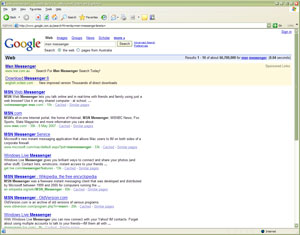The following bullet point list is just some of the information that John covered and is not meant to be complete, accurate or financial advice – just a bunch of interesting points that I remembered from the presentation:
- What type of investment options are available?
-
From an investment opportunity stand point, there are two basic options:
If you were investing for income, you are positively gearing the asset; such that you expect to receive enough rent/income from the property to pay off your debts, hopefully with some to spare. At the end of the income based investment, you have gained an asset without having to outlay any money. The by product of that is that the possible returns against the investment are much lower.
If you are investing for growth, it typically involves negative gearing (ie, that it will require some additional money from the owner to meet the repayment requirements). Investing for growth is the strategy that John employs, which involves compound growth (see below) to earn you serious money.
- What type of property should you buy?
-
There are essentially four types of real estate to invest in:
- High rise (10)
- Townhouse (20)
- Duplex (30)
- House (40)
they are listed above in least favorable to most favorable based on the land content ratio (see below).
- Where should I buy my investment property?
-
John invests according to a really simple set of rules:
- Short distance to schools, preferably good quality private schools if available
- Short distance to public transport, especially a major piece of transport infrastructure like a bus interchange or railway station
- Short to medium distance from recreational facilities
- Short to medium distance from regular shopping destinations, such as groceries
- Medium distance to the central business district
Since John invests in the standard family home, he wants to make sure that the location of that investment property suits his intended tenant; the average Australian family. From his experience, the most important items to someone tenanting an investment property relate to the children, not the parents. As such, it is more important to be close to schools than it is to be close to the parents work.
- When should I invest in property?
-
A hard question to answer directly it seems but John pointed out that the market runs in a cycle. Generally speaking, most people consider the market to cycle about every 7-8 years or 9-10 years, depending on who you talk to. In an ideal world, you would want to buy when the market is low, not high.
The tricky problem is that for as long as statistics have been kept, the price of houses doubles approximately every 7-8 years. Knowing that the price of the property is only going to go up, there really isn’t a bad time to buy unless you happen to jump in while the market is burning hot.
- How much should I pay for my investment?
-
This point was made very clear, when buying an investment property you want to be paying the mean/median price for it or below. There is no point spending the extra money on getting a ‘better house’. Remember that you’re investing as a wealth building exercise, so you need to stay emotionally detached from the investment property. There was concern in the audience about real estate market performance across time and how that’d effect the overall successfulness of the Success From Scratch strategy. John pointed out that he sticks to the mean/median price because in the event of a market slump (which will happen, so don’t kid yourself) – that the average property is effected the least, as everyone essentially needs an ‘average’ house to live in.
- Land Value Ratio
-
Land Value Ratio is the price of the land your investment sits upon, compared to the total price of the investment. If you’re investment property cost $300,000 and the land component was $100,000 then you have a land value ratio of 33%.
Beside the four types of property listed above there were numbers. Each of these numbers represents a rough percentage for the land value ratio for that type of property. It should be of no surprise that the standard house offers the best possible land content ratio, as you actually own the land.
- What makes a good investment?
-
Since everything that John went through was about investing for growth, one of the single most important points had to have been land content ratio. When you purchase an investment, he said it is safe to assume that after forty years that the above ground assets are completely written off. This comment was really two fold, not only does the physical asset need serious attention and might as well be knocked down but the Australian Tax Office will let you depreciate an investment property at about 2% per year.
Knowing that the above ground assets are going to be worth next to nothing after a forty year period is important, as if you don’t have the above ground asset – what do you have? Well you’ve still got the land, which illustrates the point John was making about land appreciating and bricks and mortar depreciating.
If you’re going to spend $x on an investment property, it makes sense that the largest possible percentage of x be made up of the land value and not the house itself. After all, the house itself is only going to cost you money over the course of time with maintenance and so forth – while the land just keeps appreciating in value!
- Where should I get my money from?
-
There didn’t seem to be any real preference towards what lender to use for your loans. I did get the impression that he was not particularly interested in the main four, especially with respect to the property valuation documents.
One important point that came out of the discussion surrounding bank loans was that you should not place your investment loans with the same lender that you have your home mortgage with. John used a phrase I hadn’t heard before, which was “cross collaterisation”. My understanding of cross collateralisation was that the bank will use your mortgage and your home as some form of securities against the investment loan. He pointed out that this was a bad thing, as it is difficult to unlink going forward and if you look to invest again further down the road – it will probably reduce your lending capacity.
- Property Valuation Documents
-
The property valuation document is apparently a very important thing that most people don’t know exists and even if they do, struggle to attain one. The property valuation document is something that your lender provides you, which outlines all sorts of important numbers about the property you’re about to invest in.
Throughout the presentation, John kept referring to the document as the foundation of which to build upon. According to John, the vast majority of lenders (especially the main ones) do not like giving out property valuation documents – in fact it is in their standard operating procedures not to.
It wasn’t covered in huge depth (just that they are very important and you need to get one), however I gathered that you can use the valuation document to take to another lender further down the road to help you get into the next investment property. Essentially, its a contact on paper that you can take to another lender and say ‘Lender X states property Y is worth Z dollars’. Without the document, the new lender will form their own opinions about the property and its worth – which might not be in your favour.
- What is the compound growth thing all about?
-
Compound growth is the technique that John uses which allows him to keep on buying property. The word compound is important, as it implies that not only is something growing but that it is growing at an ever increasing rate.
Property prices double every 7-8 years on average, so every year that you hold an asset it is going to go up in price approximately 10% (just to keep it simple). For the sake of an example, lets assume for a moment you’ve just bought a $300,000 house. The first year you hold your home, the market price for your home has increased to approximately $330,000; so you’ve just gained $30,000 in equity. The second year you hold it, you’ve now gained another 10% or $33,000 (up from $30,000 the first year).
The presentation John gave was really useful, a fair amount of it I had previously read and there was a lot of stuff I hadn’t. I think I’ll enjoy reading the book which accompanies the Success From Scratch product, it’ll no doubt clarify some of the points which weren’t covered in great detail during the presentation because of time constraints.
 Being the diligent computer user, I uninstalled MSN Messenger 7.5 and the original Windows Messenger that comes with Windows XP Professional. Not knowing the web address for MSN Messenger, I googled msn messenger to be presented with the search result to the left.
Being the diligent computer user, I uninstalled MSN Messenger 7.5 and the original Windows Messenger that comes with Windows XP Professional. Not knowing the web address for MSN Messenger, I googled msn messenger to be presented with the search result to the left. When the biggest software company in the world is required to participate in pay per click advertising on a competitors network to drive traffic to their own search engine, I think it is a pretty sure sign that their competitor is doing something right. I can understand that someone like Google and Yahoo! might advertise on their competitions web sites for pay per click marketing services but I’m yet to see an advertisement on Google or Yahoo! telling me that I should be using their competitors search engines.
When the biggest software company in the world is required to participate in pay per click advertising on a competitors network to drive traffic to their own search engine, I think it is a pretty sure sign that their competitor is doing something right. I can understand that someone like Google and Yahoo! might advertise on their competitions web sites for pay per click marketing services but I’m yet to see an advertisement on Google or Yahoo! telling me that I should be using their competitors search engines.